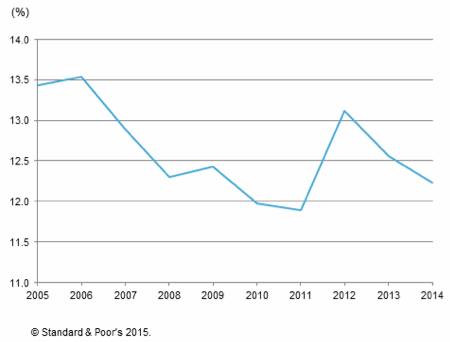Large European insurance groups’ reinsurance buying habits continue to become more centralised, resulting in the retention of more premiums to stimulate organic growth opportunities, according to S&P.
Insurance and reinsurance ratings agency Standard & Poor’s (S&P) has highlighted a growing trend with larger, primary insurance groups across Europe, “to centralize and combine reinsurance purchasing within a group structure.”
With the benign loss environment continuing, ample capacity, competition and low interest rates persisting to drive down rates across reinsurance, and increasingly primary business lines, organic growth in the majority of developed markets is becoming extremely challenging and unlikely.
While some firms might choose to cut-back, writing the most competitive business lines and even pull-out of the segments they feel simply aren’t sustainable to their operation all together, other companies have turned to consolidation in an effort to remain relevant and avoid being left behind.
Although these trends are happening across the global insurance and reinsurance landscape, analysts at S&P have noted that European players, and in particular the larger insurance groups, are becoming more opportunistic in their search for yield.
“Because organic premium growth in most mature markets across Europe is difficult to come by, primary insurers increasingly find it more sensible to retain more premiums on their own books and potentially benefit from associated profits,” explains S&P.
The establishment of a centralised, single unit for purchasing reinsurance provides a firm with a more holistic view of its operations, potentially revealing growth and exposure areas, resulting in cheaper costs and realised savings.
However, as insurers and reinsurers increasingly centralise their reinsurance buying, and retention levels rise, the result is more capital but less risk in the market place, and the possibility of greater volatility to the firms’ balance sheets, S&P underlines this point.
“Although using less reinsurance leads to greater risk retention and potential for greater volatility in primary insurers’ capital and earnings, insurers can generally absorb additional capital requirements and maintain the strength of their risk-based capital adequacy,” explains the ratings agency.
Of course retaining more risk could mean more exposure on the books, something that in a benign loss environment as we’ve seen recently can be fine, but any uptick in major losses could hurt some of the insurers retaining increasing amounts of risk if they have any gaps in their protection.
Ultimately a centralised unit for purchasing and managing reinsurance operations should provide a more comprehensive view of a firms risks, reduce costs by spending less on reinsurance and the retention of a greater capital level.
Other benefits of a centralised approach, notes S&P, include “greater bargaining power when negotiating with reinsurers to achieve more favourable pricing on terms and conditions.”
Furthermore, “some pooled risks diversify well, so the insurers have less onus to cede them externally,” continues S&P.
The result of the changing buying habits highlighted by S&P in its report, ‘The Latest Twists In The Co-Evolution Of European Insurers And Reinsurers,’ and discussed in this article, will heighten competition in the reinsurance space and, as emphasised in the chart below has resulted in a decline in reinsurance utilisation by the top 20 property writers in Europe.

Reinsurance utilisation for 20 largest European property casualty insurers
Another development regarding the changing reinsurance buying habits of European insurers and reinsurers explored by S&P, underlines a shift from cedants to purchase less reinsurance protection for low-severity risks, and growing their use of reinsurance for high-severity, less frequent exposures.

Probable maximum loss/gross 1:250 PML for 10 largest rated European P/C insurers
“Changing buying patterns among insurers will heighten competition across the reinsurance sector, and are defining the lines between winning and losing reinsurers. For cedants, reinsurance now offers cheaper protection while optimizing their business cessions.
“If mismanaged, cedants could end up with more risk and undue volatility on their balance sheets, ultimately placing their creditworthiness at risk,” concludes S&P.
Also read:
– Solvency II to increase reinsurance (and ILS) demand in Europe: S&P.
 View all of our Artemis Live video interviews and subscribe to our podcast.
View all of our Artemis Live video interviews and subscribe to our podcast.
All of our Artemis Live insurance-linked securities (ILS), catastrophe bonds and reinsurance video content and video interviews can be accessed online.
Our Artemis Live podcast can be subscribed to using the typical podcast services providers, including Apple, Google, Spotify and more.































